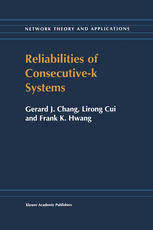
Reliabilities of Consecutive-k Systems PDF
Preview Reliabilities of Consecutive-k Systems
Reliabilities of Consecutive-k Systems Network Theory and Applications Volume 4 Managing Editors: Ding-Zhu Du, University ofM innesota, U.S.A. and Cauligi Raghavendra, University ofS outhern California, U.S.A. The titles published in this series are listed at the end oft his volume. Reliabilities of Consecutive-k Systems by Gerard 1. Chang Department ofA pplied Mathematics, National Chiao Tung University. Hsinchu, Taiwan, R.o.C. Lirong Cui Reliability and Safety Research Center, China Aerospace Corporation, PRo China and Frank K. Hwang Department ofA pplied Mathematics, National Chiao Tung University, Hsinchu, Taiwan, R.o.C. KLUWER ACADEMIC PUBLISHERS DORDRECHT I BOSTON I LONDON A C.I.P. Catalogue record for this book is available from the Library of Congress. ISBN-13:978-1-4613-7972-0 e-ISBN-13:978-1-4613-0273-5 DOl: 10.1007/978-1-4613-0273-5 Published by Kluwer Academic Publishers, P.o. Box 17,3300 AA Dordrecht, The Netherlands. Sold and distributed in North, Central and South America by Kluwer Academic Publishers, 101 Philip Drive, Norwell, MA 02061, U.S.A. In all other countries, sold and distributed by Kluwer Academic Publishers, P.O. Box 322, 3300 AH Dordrecht, The Netherlands. Printed on acid-free paper All Rights Reserved © 2000 Kluwer Academic Publishers Softcover reprint of the hardcover 1st edition 2000 No part of the material protected by this copyright notice may be reproduced or utilized in any form or by any means, electronic or mechanical, including photocopying, recording or by any information storage and retrieval system, without written permission from the copyright owner. Contents List of Figures Vll Preface ix 1. INTRODUCTION 1 1.1 The consecutive system and generalizations 1 1.2 The problems and the methodologies 3 1.3 Notation 5 2. COMPUTATION OF RELIABILITY 7 2.1 Recursive equations 7 2.2 The matrix approach 12 2.3 The combinatorial approach 15 2.4 Bounds and approximations 21 3. DESIGN OF OPTIMAL CONSECUTIVE SYSTEMS 29 3.1 Optimal consecutive-2 systems 29 3.2 Invariant consecutive-k systems 34 3.3 The Birnbaum importance 36 3.4 Half-line importance 44 3.5 The combinatorial importance and the rare-event importance 48 3.6 Consecutive-k G system 54 4. THE LIFETIME DISTRIBUTION 61 4.1 Mean time to failure 61 4.2 Estimation of Parameters 65 4.3 Increasing failure rate preservation 68 4.4 IFR property for k ~ 4 72 5. ASYMPTOTIC ANALYSIS 77 5.1 Elementary method 77 5.2 Generating function method 80 v VI RELIABILITIES OF CONSECUTIVE-k SYSTEMS 5.3 Poisson convergence method 81 5.4 The dependence models 83 5.5 Distribution for exchangeable lifetimes 90 6. WINDOW SYSTEMS 93 6.1 The k-within-consecutive-m-out- of-n system 93 6.2 The (2, m, n) system 98 6.3 b-Fold-window systems 102 6.4 Asymptotic analysis 105 7. THE NETWORK MODEL 111 7.1 The linear consecutive-2 network system 111 7.2 Connectivity and hamiltonian reliability 115 7.3 The reversible model 119 7.4 The k ~ 3 case 123 8. CONSECUTIVE-2 GRAPHS 127 8.1 Reliabilities of consecutive-2 graphs 127 8.2 Optimal consecutive-2 graphs: general theory 130 8.3 Invariant d-nary trees 134 8.4 Other consecutive-2 graphs 141 8.5 The 2-dimensional case 142 9. SOME RELATED SYSTEMS 149 9.1 Consecutively connected systems 149 9.2 Multi-failure consecutive systems 153 9.3 Redundant consecutive-k systems 157 9.4 Weighted consecutive systems 161 10. APPLICATIONS 165 10.1 Examples of modelings 165 10.2 Application examples with computations 169 References 185 Index 207 List of Figures 3.1.1 The optimal consecutive-2 circular system. 31 3.1.2 Three circular systems. 32 3.3.1 h(i} for the consecutive-2-out-of-12 line. 40 3.6.1 The unique invariant consecutive-k-out-of-n G cycle. 57 7.3.1 A path with a backward link. 120 8.1.1 Sequenceable graphs. 128 8.1.2 A series-parallel graph and compositions. 129 8.3.1 Example of a supertree. 137 8.3.2 A standard caterpillar. 137 8.3.3 Invariant caterpillars. 138 8.3.4 Invariant multi-star. 139 8.3.5 Invariant multi-caterpillar. 139 8.3.6 Mapping the (1, d}-tree to the (h, d}-tree. 140 8.3.7 Mapping the (2,3}-tree to the (h,3}-tree. 140 8.3.8 Mapping caterpillars with lines. 140 8.4.1 Comparisons of nodes in T2 (d). 141 8.5.1 Linear and circular lattice systems. 143 9.1.1 Reducing a circular set of cutsets to linear. 153 10.1.1 Detection pattern. 167 10.1.2 Power supply line digram. 167 10.1.3 A network with the consecutive-2 structure. 168 10.1.4 Working/failed system. 169 10.1.5 Temperature sensor digram. 169 10.2.1 Satellite communication system. 170 10.2.2 A monitoring system with seven cameras. 176 10.2.3 Diagram of camera system. 177 10.2.4 Network diagram. 178 10.2.5 Detector / channel/preamplifer reliability diagram. 180 10.2.6 Bank automatic payment system. 181 vii viii RELIABILITIES OF CONSECUTIVE-k SYSTEMS 10.2.7 Tube arrangement diagram. 183 Preface The consecutive-k system was first studied around 1980, and it soon became a very popular subject. The reasons were many-folded, includ ing: 1. The system is simple and natural. So most people can understand it and many can do some analysis. Yet it can grow in many directions and there is no lack of new topics. 2. The system is simple enough to become a prototype for demonstrat ing various ideas related to reliability. For example, the interesting concept of component importance works best with the consecutive-k system. 3. The system is supported by many applications. Twenty years have gone and hundreds of papers have been published on the subject. This seems to be a good time for retrospect and to sort the scattered material into a book. Besides providing our own per spective, the book will also serve as an easy reference to the numerous ramifications of the subject. It is hoped that a summary of work in the current period will become the seed of future break-through. GERARD J. CHANG, LIRONG CUI, FRANK K. HWANG IX
